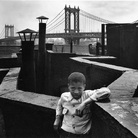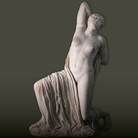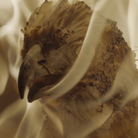Quel che resta del giorno / Momenti Decisivi / L’Italia positiva di Stefano Robino. Fotografie 1951-1969

Dario Caputo, 2013
Dal 6 February 2015 al 12 April 2015
Venezia
Luogo: Casa dei Tre Oci
Indirizzo: Fondamenta delle Zitelle 43
Orari: 10-18; chiuso martedì
Telefono per informazioni: +39 041 2412332
E-Mail info: info@treoci.org
Sito ufficiale: http://www.treoci.org
Il programma espositivo del Circolo Fotografico La Gondola presso la Casa dei Tre Oci all’interno della rassegna Tre Oci Tre Mostre, si articolerà in tre sezioni:
Quel che resta del giorno, riprendendo il titolo di un fortunato film di James Ivory, è il tema che ha visto riflettere quest’anno 31 soci del Circolo. Due i principali ambiti di ricerca.
Il primo, e forse il più importante, riguarda la memoria personale formata non già dagli avvenimenti salienti di una vita ma dai piccoli dettagli, dai particolari marginali, dai riverberi di azioni banali che per effetto della trasfigurazione fotografica assumono valore altro, simbolico e aperto a più significati.
Non si tratta di registrare il diario visivo di una giornata (come il titolo potrebbe far pensare) ma dare consistenza a dettagli del proprio vissuto, non importa se recente o lontano. Una sorta di evocazione intima, profonda, di cui rendere partecipe lo spettatore.
Altra possibile lettura è la parafrasi della labilità del vivere e l’assenza di autentici valori di riferimento nella società contemporanea; si prendono in considerazione i manufatti umani di cui si vogliono cogliere il disfacimento, il degrado che essi subiscono per effetto dell’uso, dell’azione del tempo e il loro successivo abbandono che spesso dà luogo a nuove evidenze dense d’inaspettati significati.
Ma non solo; l’antropizzazione del territorio, l’inarrestabile avanzata degli insediamenti umani modificano temporaneamente o definitivamente situazioni e ambienti ritenuti per molto tempo immutabili.
Gli autori della Gondola si soffermano su questi cambiamenti senza peraltro porre l’accento sulle ragioni dell’intervento ma, attraverso la semplice constatazione dell’avvenuto, indirizzare o meglio suscitare una riflessione, qualsiasi essa sia.
Partecipano i soci Andrea Avezzù, Antonio Baldi, Maurizio Braiato, Aldo Brandolisio, Fabri- zio Brugnaro, Lorenzo Bullo, Nicola Bustreo, Dario Caputo, Paola Casanova, Carlo Chiapponi, Maria Teresa Crisigiovanni, Francesco Del Negro, Franco Furneri, Stefania Galluccio, Gianfranco Giantin, Mirella La Rosa, Matteo Miotto, Aldo Navoni, Stefano Pandiani, San- dro Pizzolato, Giovanni Puppini, Alessandro Rizzardini, David Salvadori, Giorgio Semen- zato, Massimo Stefanutti, Maurizio Trifilidis, Fabrizio Uliana, Isabella Vegh, Giovanni Vio, Emilio Zangiacomi, Anna Zemella.
Una stanza è dedicata ai vincitori della lettura portfolio che si è tenuta nel gennaio 2014 ai Tre Oci: Momenti decisivi è l’occasione per una rilettura e valorizzazione del reportage attuale alla luce dei nuovi mezzi di registrazione.
Tre gli autori selezionati, che presenteranno i lavori premiati.
Andrea Bianco, con il lavoro Faces, in cui viene ben rappresentato il dualismo tra figura statica e dinamica, la prima densa di bellezza irraggiungibile, la seconda transitoria e umana. Elisa Gambino, premiata per il lavoro Figli del Vento che attraverso un’originale forma espressiva propone un percorso emozionale che coniuga bene reportage e ricerca. Monia Perissinotto con Havana, che traendo origine dal citizen journalism elabora un progetto definito e autoriale attraverso l’uso delle nuove tecnologie digitali, evidenziando una coerente ricerca cromatica e compositiva.
Ad arricchire l’offerta espositiva, la Gondola ha scelto di presentare quest’anno L’Italia positiva di Stefano Robino. Fotografie 1951-1969.
Nato a Torino nel 1922, Stefano Robino fotografa dagli inizi degli anni ‘50 aderendo al “Gruppo Culturale FIAT – Sezione Fotografia”. La nascita del figlio lo spinge a concentrar- si sull’accattivante tema della famiglia con cui conseguirà importanti riscontri in campo nazionale e internazionale; successivamente il suo sguardo volgerà al mondo del lavoro, agli aspetti della solidarietà e alle realtà sociale più trascurate.
Sempre all’interno della FIAT Grandi Motori, Robino diviene dapprima responsabile del laboratorio fotografico (1965) e successivamente (1971) responsabile dell’ufficio Pub- blicità.
Nel 1971 la Grandi Motori Trieste pubblica un suo volume sull’analogo stabilimento di To- rino, nel 2002 la Regione Piemonte arreda con 99 pannelli di sue fotografie gli uffici delle gestione e sviluppo delle Risorse Umane nella palazzina ex sede della S.E.I.
La vicenda fotografica di Stefano Robino costituisce una sorta di trait d’union tra la pro- duzione amatoriale dei primi anni ‘50 fortemente condizionata dalle ultime propaggini del neorealismo e le soluzioni più intimistiche affioranti man mano che si avvertono i pri- mi segnali del boom economico.
I fotografi prestano crescente attenzione all’ambiente familiare visto con calore parteci- pativo e non già, come suggeriva la visione neorealista, come estrema sintesi di un’ingrata condizione di vita .
Sono molteplici le tematiche affrontate dall’autore a testimonianza di un’irrequietezza dello sguardo che supera le convenzioni e gli stilemi amatoriali.
Esempi significativi sono il paesaggio, le periferie, le fabbriche dai toni scuri e desolati ben lontani dalle arcadiche visioni di tanti fotoamatori; persino le pecore al pascolo, tema tra i più abusati, sono viste con sorprendente originalità.
Si è detto della famiglia che spesso costituisce pretesto per composizioni agili e originali, piene di freschezza narrativa; in questo contesto importante è la ritrattistica, mai banale e priva di retorica.
Robino si dimostra soprattutto reporter di assoluta qualità; la straordinaria sequenza della partenza del transatlantico “Cristoforo Colombo”, che porta lontano dalla patria centinaia di migranti è una delle pagine più belle della fotografia di quegli anni; la strug- gente malinconia degli addii e le commoventi figure dei familiari protesi in un ultimo sa- luto sono rese con emozionata, accorata partecipazione.
Robino conferma le sue qualità anche nella serie “Bambini ai giardini” e “In processione” dove ancora si avvertono i riflessi della stagione neorealista che tuttavia non impediscono all’Autore di far valere la sua caratura autoriale.
Da non dimenticare infine i lavori fotografici dedicati all’ambiente di lavoro, la FIAT Grandi Motori, dove l’autore ha modo di applicare tutte le sue conoscenze tecniche e operative. Nelle parole del Presidente del Circolo Fotografico La Gondola, Manfredo Manfroi, “con- clusa da tempo la parabola produttiva, una consapevole rilettura critica è oggi in grado di rivalutare l’opera di Robino e assegnargli lo spazio che merita nella storia della fotografia italiana; un peso non indifferente, una traccia sicura ed originale che forse ci riserva ancora delle sorprese”.
La mostra allestita al secondo piano della Casa dei Tre Oci fa parte della rassegna TRE OCI TRE MOSTRE GIUDECCA FOTOGRAFIA, format di successo giunto alla terza edizione, che inaugura la stagione espositiva 2015 della Casa dei Tre Oci, dedicata alla fotografia. Un percorso di ricerca articolato su più livelli, che trasforma i Tre Oci in una vera e propria Kunsthaus, proponendo anche quest’anno un percorso visivo di confronto tra i linguaggi contemporanei e la grande tradizione della fotografia veneziana.
Tre proposte espositive differenti fra loro che cercano di interpretare l’essenza della fotografia di oggi in una logica che si muove verso i superamenti dei generi e la trasversalità. Una fotografia capace di interpretare l’idea del cambiamento senza appartenere a scuole di pensiero precostituito.
Al pianterreno della Casa, Sguardi privati. Fotografie di Francesco Maria Colombo. Sessanta ritratti, tra bianco e nero e colore.
Al primo piano, la mostra Le gallerie veneziane e la fotografia: in realtà sei mostre, ognuna in una stanza, che rappresentano sei gallerie veneziane che da sempre operano nel campo della fotografia.
La Fondazione di Venezia negli anni ha acquisito vari archivi e fondi fotografici per dedicarli alla fruizione e in generale alla diffusione della cultura fotografica in Italia, e in particolare a Venezia dove ha aperto al pubblico la Casa dei Tre Oci. Ai Tre Oci la fotografia ha trovato la propria casa con mostre, workshop, seminari, laboratori, convegni, e importanti esposizioni monografiche dei grandi maestri della scena internazionale.
Il progetto Tre Oci è sviluppato in collaborazione con Civita Tre Venezie e con il sostegno di Veneto Banca e Grafica Veneta.
Quel che resta del giorno, riprendendo il titolo di un fortunato film di James Ivory, è il tema che ha visto riflettere quest’anno 31 soci del Circolo. Due i principali ambiti di ricerca.
Il primo, e forse il più importante, riguarda la memoria personale formata non già dagli avvenimenti salienti di una vita ma dai piccoli dettagli, dai particolari marginali, dai riverberi di azioni banali che per effetto della trasfigurazione fotografica assumono valore altro, simbolico e aperto a più significati.
Non si tratta di registrare il diario visivo di una giornata (come il titolo potrebbe far pensare) ma dare consistenza a dettagli del proprio vissuto, non importa se recente o lontano. Una sorta di evocazione intima, profonda, di cui rendere partecipe lo spettatore.
Altra possibile lettura è la parafrasi della labilità del vivere e l’assenza di autentici valori di riferimento nella società contemporanea; si prendono in considerazione i manufatti umani di cui si vogliono cogliere il disfacimento, il degrado che essi subiscono per effetto dell’uso, dell’azione del tempo e il loro successivo abbandono che spesso dà luogo a nuove evidenze dense d’inaspettati significati.
Ma non solo; l’antropizzazione del territorio, l’inarrestabile avanzata degli insediamenti umani modificano temporaneamente o definitivamente situazioni e ambienti ritenuti per molto tempo immutabili.
Gli autori della Gondola si soffermano su questi cambiamenti senza peraltro porre l’accento sulle ragioni dell’intervento ma, attraverso la semplice constatazione dell’avvenuto, indirizzare o meglio suscitare una riflessione, qualsiasi essa sia.
Partecipano i soci Andrea Avezzù, Antonio Baldi, Maurizio Braiato, Aldo Brandolisio, Fabri- zio Brugnaro, Lorenzo Bullo, Nicola Bustreo, Dario Caputo, Paola Casanova, Carlo Chiapponi, Maria Teresa Crisigiovanni, Francesco Del Negro, Franco Furneri, Stefania Galluccio, Gianfranco Giantin, Mirella La Rosa, Matteo Miotto, Aldo Navoni, Stefano Pandiani, San- dro Pizzolato, Giovanni Puppini, Alessandro Rizzardini, David Salvadori, Giorgio Semen- zato, Massimo Stefanutti, Maurizio Trifilidis, Fabrizio Uliana, Isabella Vegh, Giovanni Vio, Emilio Zangiacomi, Anna Zemella.
Una stanza è dedicata ai vincitori della lettura portfolio che si è tenuta nel gennaio 2014 ai Tre Oci: Momenti decisivi è l’occasione per una rilettura e valorizzazione del reportage attuale alla luce dei nuovi mezzi di registrazione.
Tre gli autori selezionati, che presenteranno i lavori premiati.
Andrea Bianco, con il lavoro Faces, in cui viene ben rappresentato il dualismo tra figura statica e dinamica, la prima densa di bellezza irraggiungibile, la seconda transitoria e umana. Elisa Gambino, premiata per il lavoro Figli del Vento che attraverso un’originale forma espressiva propone un percorso emozionale che coniuga bene reportage e ricerca. Monia Perissinotto con Havana, che traendo origine dal citizen journalism elabora un progetto definito e autoriale attraverso l’uso delle nuove tecnologie digitali, evidenziando una coerente ricerca cromatica e compositiva.
Ad arricchire l’offerta espositiva, la Gondola ha scelto di presentare quest’anno L’Italia positiva di Stefano Robino. Fotografie 1951-1969.
Nato a Torino nel 1922, Stefano Robino fotografa dagli inizi degli anni ‘50 aderendo al “Gruppo Culturale FIAT – Sezione Fotografia”. La nascita del figlio lo spinge a concentrar- si sull’accattivante tema della famiglia con cui conseguirà importanti riscontri in campo nazionale e internazionale; successivamente il suo sguardo volgerà al mondo del lavoro, agli aspetti della solidarietà e alle realtà sociale più trascurate.
Sempre all’interno della FIAT Grandi Motori, Robino diviene dapprima responsabile del laboratorio fotografico (1965) e successivamente (1971) responsabile dell’ufficio Pub- blicità.
Nel 1971 la Grandi Motori Trieste pubblica un suo volume sull’analogo stabilimento di To- rino, nel 2002 la Regione Piemonte arreda con 99 pannelli di sue fotografie gli uffici delle gestione e sviluppo delle Risorse Umane nella palazzina ex sede della S.E.I.
La vicenda fotografica di Stefano Robino costituisce una sorta di trait d’union tra la pro- duzione amatoriale dei primi anni ‘50 fortemente condizionata dalle ultime propaggini del neorealismo e le soluzioni più intimistiche affioranti man mano che si avvertono i pri- mi segnali del boom economico.
I fotografi prestano crescente attenzione all’ambiente familiare visto con calore parteci- pativo e non già, come suggeriva la visione neorealista, come estrema sintesi di un’ingrata condizione di vita .
Sono molteplici le tematiche affrontate dall’autore a testimonianza di un’irrequietezza dello sguardo che supera le convenzioni e gli stilemi amatoriali.
Esempi significativi sono il paesaggio, le periferie, le fabbriche dai toni scuri e desolati ben lontani dalle arcadiche visioni di tanti fotoamatori; persino le pecore al pascolo, tema tra i più abusati, sono viste con sorprendente originalità.
Si è detto della famiglia che spesso costituisce pretesto per composizioni agili e originali, piene di freschezza narrativa; in questo contesto importante è la ritrattistica, mai banale e priva di retorica.
Robino si dimostra soprattutto reporter di assoluta qualità; la straordinaria sequenza della partenza del transatlantico “Cristoforo Colombo”, che porta lontano dalla patria centinaia di migranti è una delle pagine più belle della fotografia di quegli anni; la strug- gente malinconia degli addii e le commoventi figure dei familiari protesi in un ultimo sa- luto sono rese con emozionata, accorata partecipazione.
Robino conferma le sue qualità anche nella serie “Bambini ai giardini” e “In processione” dove ancora si avvertono i riflessi della stagione neorealista che tuttavia non impediscono all’Autore di far valere la sua caratura autoriale.
Da non dimenticare infine i lavori fotografici dedicati all’ambiente di lavoro, la FIAT Grandi Motori, dove l’autore ha modo di applicare tutte le sue conoscenze tecniche e operative. Nelle parole del Presidente del Circolo Fotografico La Gondola, Manfredo Manfroi, “con- clusa da tempo la parabola produttiva, una consapevole rilettura critica è oggi in grado di rivalutare l’opera di Robino e assegnargli lo spazio che merita nella storia della fotografia italiana; un peso non indifferente, una traccia sicura ed originale che forse ci riserva ancora delle sorprese”.
La mostra allestita al secondo piano della Casa dei Tre Oci fa parte della rassegna TRE OCI TRE MOSTRE GIUDECCA FOTOGRAFIA, format di successo giunto alla terza edizione, che inaugura la stagione espositiva 2015 della Casa dei Tre Oci, dedicata alla fotografia. Un percorso di ricerca articolato su più livelli, che trasforma i Tre Oci in una vera e propria Kunsthaus, proponendo anche quest’anno un percorso visivo di confronto tra i linguaggi contemporanei e la grande tradizione della fotografia veneziana.
Tre proposte espositive differenti fra loro che cercano di interpretare l’essenza della fotografia di oggi in una logica che si muove verso i superamenti dei generi e la trasversalità. Una fotografia capace di interpretare l’idea del cambiamento senza appartenere a scuole di pensiero precostituito.
Al pianterreno della Casa, Sguardi privati. Fotografie di Francesco Maria Colombo. Sessanta ritratti, tra bianco e nero e colore.
Al primo piano, la mostra Le gallerie veneziane e la fotografia: in realtà sei mostre, ognuna in una stanza, che rappresentano sei gallerie veneziane che da sempre operano nel campo della fotografia.
La Fondazione di Venezia negli anni ha acquisito vari archivi e fondi fotografici per dedicarli alla fruizione e in generale alla diffusione della cultura fotografica in Italia, e in particolare a Venezia dove ha aperto al pubblico la Casa dei Tre Oci. Ai Tre Oci la fotografia ha trovato la propria casa con mostre, workshop, seminari, laboratori, convegni, e importanti esposizioni monografiche dei grandi maestri della scena internazionale.
Il progetto Tre Oci è sviluppato in collaborazione con Civita Tre Venezie e con il sostegno di Veneto Banca e Grafica Veneta.
SCARICA IL COMUNICATO IN PDF
casa dei tre oci
·
aldo brandolisio
·
paola casanova
·
gianfranco giantin
·
antonio baldi
·
maurizio braiato
·
lorenzo bullo
·
nicola bustreo
·
dario caputo
·
carlo chiapponi
·
maria teresa crisigiovanni
·
francesco del negro
·
franco furneri
·
stefania galluccio
·
COMMENTI

-
 Dal 2 December 2025 al 19 February 2026
Milano | Centro Culturale di Milano
Dal 2 December 2025 al 19 February 2026
Milano | Centro Culturale di Milano
Walter Rosenblum. Il mondo e la tenerezza
-
 Dal 30 November 2025 al 12 April 2026
Gallarate | Museo MA*GA
Dal 30 November 2025 al 12 April 2026
Gallarate | Museo MA*GA
Kandinsky e l’Italia
-
 Dal 29 November 2025 al 12 April 2026
Roma | Musei Capitolini
Dal 29 November 2025 al 12 April 2026
Roma | Musei Capitolini
La Grecia a Roma
-
 Dal 22 November 2025 al 3 May 2026
Torino | Sale Chiablese dei Musei Reali
Dal 22 November 2025 al 3 May 2026
Torino | Sale Chiablese dei Musei Reali
Orazio Gentileschi. Un pittore in viaggio
-
 Dal 20 November 2025 al 25 January 2026
Firenze | Palazzo Strozzi
Dal 20 November 2025 al 25 January 2026
Firenze | Palazzo Strozzi
Andro Eradze. Bones of Tomorrow
-
 Dal 21 November 2025 al 28 March 2026
Cuneo | Complesso Monumentale di San Francesco
Dal 21 November 2025 al 28 March 2026
Cuneo | Complesso Monumentale di San Francesco
La Galleria Borghese. Da Raffaello a Bernini. Storia di una collezione


